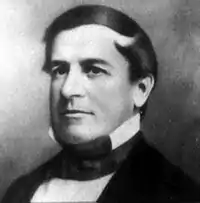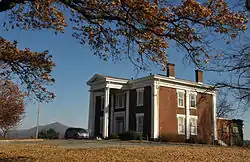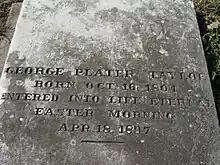George Plater Tayloe | |
|---|---|
 George Plater Tayloe | |
| Born | October 15, 1804 |
| Died | April 18, 1897 (aged 92) |
| Nationality | American |
| Occupation(s) | Planter, military officer |
| Relatives | Henry Scarsbrook Langhorne (uncle in-law) Nancy Astor, Viscountess Astor (cousin) |
George Plater Tayloe ( October 15, 1804 – Apr 18, 1897) was a Virginia businessman, soldier and legislator who also served as one of the original trustees of Hollins University.
Early life
George Tayloe was born October 15, 1804, at Mount Airy in Richmond County, Virginia, the ninth of fifteen children of Hon. John Tayloe III. He was born into a large aristocratic family of great wealth that had accumulated over three generations, beginning with John Tayloe I, son of the immigrant, one of the richest plantation owners and businessmen in Virginia for his generation. Considered to be the chief architect of the family fortune,[1] he was known as the "Hon. Colonel of the Old House". The Tayloe family of Richmond County, including John Tayloe I, his son, John Tayloe II, and grandson, John Tayloe III, exemplified gentry entrepreneurship.[2]
George Tayloe attended Princeton University. Following his graduation he moved to the western part of the state to manage a source of the family income-two iron furnaces, Catawba II and Cloverdale. These furnaces along with 1132 acres of land around Cloverdale had been purchased by the Tayloes from a Thomas Madison in 1817. George Tayloe married Mary Elizabeth Langhorne in 1830, and in 1833 he traded with his father-in-law, Colonel William Langhorne, a section of the Cloverdale property for the 598-acre Buena Vista tract.
This tract or plantation originally was known as "Roanoke" after the river which flowed at the edge of the land, but the name was changed to "Buena Vista" in 1838 when a section of lower Botetourt County became Roanoke County. Tayloe razed the Langhorne house and erected the present Greek Revival dwelling on the plantation's most commanding site. The construction date for Tayloe's house traditionally is given as 1833, the year he acquired the land, but architectural evidence indicates it is closer to 1840. In any case, the 10,783-square-foot mansion would have taken several years to build.[3] "Buena Vista" was built of red brick said to be imported from England; the walls of the house are 18 inches thick. It barely escaped burning at the hands of General David Hunter at the time of the burning of Virginia Military Institute, but was saved from destruction by a report that General Jubal Early and his staff were there.

George Tayloe was a prominent figure in both state and local affairs. He represented Roanoke County in the state legislature, and was a signer of the Ordinance of Secession, although he originally was opposed to secession.[4] Tayloe is remembered in the Roanoke area chiefly for his many years of support of Hollins University. His financial aid saw the school through difficult times and in 1844 he became one of the original thirteen members of the Board of Trustees. He later was made Chairman of the Board and remained in that position until his death. Tayloe was a charter member of the Valley Union Education Society. He was also a charter member of Roanoke College. He was an avid promoter of the establishment and development of the City of Roanoke, particularly through the Buena Vista Land Company.
Four of George's sons fought as Confederate soldiers.
Later career
Tayloe was one of the three cotton planters who owned considerable estates in Arcola, Alabama, in 1860. Mr. Tayloe owned "Elmwood" (1,140 acres). He did not live there, however. He bought the place at public auction. He also owned the Walnut Grove plantation, some eight miles eastward on the Uniontown and Demopolis road.
All of the grandsons of Col. John Tayloe of the revolutionary time were soldiers of the Southern Confederacy. One of the sons-in-law of Mr. George P. Tayloe was Brigadier General Thomas T. Mumford of Virginia, one of the commanders of the cavalry of the Army of Northern Virginia.

George died on April 18, 1897, in "Buena Vista", Roanoke Co., Virginia.
The Octagon

Tayloe had very close ties to Washington, D.C. His father built the Octagon House in 1799. The Octagon was designed by Dr. William Thornton, the first architect of the U.S. Capitol.[5] In 1814, Colonel Tayloe offered the use of his home to President James Madison and his wife, Dolley, for a temporary "Executive Mansion" after the burning of the White House by the British. Madison used the circular room above the entrance as a study and there, on February 17, 1815, he signed the Treaty of Ghent which ended the War of 1812.[6]
Apparitions and the presence of otherworldly forces have reportedly been seen and felt in many places at The Octagon, including on the spiral staircase, the second floor landing, the third floor landing, the third floor bedroom, and the garden area in the rear. Among the eyewitnesses have been members of the public, curators and other employees hired by the museum which owns the house.[7]
Children

George Tayloe had ten children:

- John William Tayloe CSA
- Elizabeth Henrietta Tayloe
- Ann Catherine Tayloe "Nannie"
- Mary Lavinia Tayloe
- George Edward Tayloe CSA
- Rose Matilda Tayloe
- James Langhorne Tayloe CSN – Killed in the Battle of Hampton Roads[8]
- Lomax Tayloe CSA
- Henry Wharton Tayloe
- Virginia "Jenny" Tayloe
Ancestry
| Ancestors of George Plater Tayloe | ||||||||||||||||||||||||||||||||||||||||||||||||||||||||||||||||||||||||||||||||||||||||||||||||||||||||||||||||||||||||||||||||||||||||||||||||||||||||||||||||||||||||||||||||||||||||||||||||||||||||||||||||||||||||||||||||||||||||||||||||||||||||||||||||||||||||||||||||||||||||||||||||||||||||||||||||||||||||||||||||||||||||||||||||||||||||||||||||||||||||||||||||||||||||||||||||||||||||||||||||||||||||||||||||||||||||||||||||||||||||||||||||||||||||||||||||||||||||||||||||||||||||||||||||||||||||||||||||||||||||||||||||||||||||||||||||||||||||||||||||||||||||||||||||||||||||||||||||
|---|---|---|---|---|---|---|---|---|---|---|---|---|---|---|---|---|---|---|---|---|---|---|---|---|---|---|---|---|---|---|---|---|---|---|---|---|---|---|---|---|---|---|---|---|---|---|---|---|---|---|---|---|---|---|---|---|---|---|---|---|---|---|---|---|---|---|---|---|---|---|---|---|---|---|---|---|---|---|---|---|---|---|---|---|---|---|---|---|---|---|---|---|---|---|---|---|---|---|---|---|---|---|---|---|---|---|---|---|---|---|---|---|---|---|---|---|---|---|---|---|---|---|---|---|---|---|---|---|---|---|---|---|---|---|---|---|---|---|---|---|---|---|---|---|---|---|---|---|---|---|---|---|---|---|---|---|---|---|---|---|---|---|---|---|---|---|---|---|---|---|---|---|---|---|---|---|---|---|---|---|---|---|---|---|---|---|---|---|---|---|---|---|---|---|---|---|---|---|---|---|---|---|---|---|---|---|---|---|---|---|---|---|---|---|---|---|---|---|---|---|---|---|---|---|---|---|---|---|---|---|---|---|---|---|---|---|---|---|---|---|---|---|---|---|---|---|---|---|---|---|---|---|---|---|---|---|---|---|---|---|---|---|---|---|---|---|---|---|---|---|---|---|---|---|---|---|---|---|---|---|---|---|---|---|---|---|---|---|---|---|---|---|---|---|---|---|---|---|---|---|---|---|---|---|---|---|---|---|---|---|---|---|---|---|---|---|---|---|---|---|---|---|---|---|---|---|---|---|---|---|---|---|---|---|---|---|---|---|---|---|---|---|---|---|---|---|---|---|---|---|---|---|---|---|---|---|---|---|---|---|---|---|---|---|---|---|---|---|---|---|---|---|---|---|---|---|---|---|---|---|---|---|---|---|---|---|---|---|---|---|---|---|---|---|---|---|---|---|---|---|---|---|---|---|---|---|---|---|---|---|---|---|---|---|---|---|---|---|---|---|---|---|---|---|---|---|---|---|---|---|---|---|---|---|---|---|---|---|---|---|---|---|---|---|---|---|---|---|---|---|---|---|---|---|---|---|---|---|---|---|---|---|---|---|---|---|---|---|---|---|---|---|---|---|---|---|---|---|---|---|---|---|---|---|---|---|---|---|---|---|---|---|---|---|---|---|---|---|---|---|---|---|---|---|---|---|---|---|---|---|---|---|---|---|---|---|---|---|---|---|---|---|---|---|---|---|---|---|---|---|---|---|---|---|---|---|---|---|---|---|---|---|---|---|---|---|---|---|---|---|---|---|---|---|---|---|---|---|---|---|---|---|---|---|---|---|---|---|---|---|---|---|---|---|---|---|---|---|---|---|---|---|---|---|---|---|---|---|---|---|---|---|
| ||||||||||||||||||||||||||||||||||||||||||||||||||||||||||||||||||||||||||||||||||||||||||||||||||||||||||||||||||||||||||||||||||||||||||||||||||||||||||||||||||||||||||||||||||||||||||||||||||||||||||||||||||||||||||||||||||||||||||||||||||||||||||||||||||||||||||||||||||||||||||||||||||||||||||||||||||||||||||||||||||||||||||||||||||||||||||||||||||||||||||||||||||||||||||||||||||||||||||||||||||||||||||||||||||||||||||||||||||||||||||||||||||||||||||||||||||||||||||||||||||||||||||||||||||||||||||||||||||||||||||||||||||||||||||||||||||||||||||||||||||||||||||||||||||||||||||||||||
References
- ↑ McCusker, John J.; Morgan, Kenneth (2000). The early modern Atlantic economy. Cambridge University Press. pp. 347–. ISBN 978-0-521-78249-4. Retrieved 17 October 2011.
- ↑ Kamoie, Laura Croghan (March 2008). "The Business History of the Virginia Gentry" (PDF). web.archive.org. Retrieved 2023-11-15.
- ↑ "Archived copy" (PDF). Archived from the original (PDF) on 2015-09-24. Retrieved 2014-12-19.
{{cite web}}: CS1 maint: archived copy as title (link) - ↑ White, Clare (1982). Roanoke 1740-1982. Roanoke Valley Historical Society. p. 53.
- ↑ "The History of The Octagon". archfoundation.org. American Architectural Foundation. Archived from the original on 9 September 2011. Retrieved 16 October 2011.
- ↑ "National Park Service - The Presidents (Octagon House)".
- ↑ Hauck, Dennis. Haunted Places: The National Directory. 2d ed. New York: Penguin Group, 2002. ISBN 0-14-200234-8
- ↑ Langhorne, James Callaway (2013). The Virginia Langhornes. Lynchburg, Virginia: Blackwell Press. p. 103. ISBN 978-1-938205-10-1.
Further reading
- Dunn, Richard S (2014). A Tale of Two Plantations : Slave Life and Labor in Jamaica and Virginia. Harvard University Press. ISBN 9780674735361
- Kamoie, Laura Croghan (2007). Irons in the Fire : The Business History of the Tayloe Family and Virginia's Gentry, 1700-1860. Charlottesville: University of Virginia Press. ISBN 9780813926377
- Payden-Travers, Jack (1997). A Case Study of George Plater Tayloe and Buena Vista (MALS thesis). Hollins University.